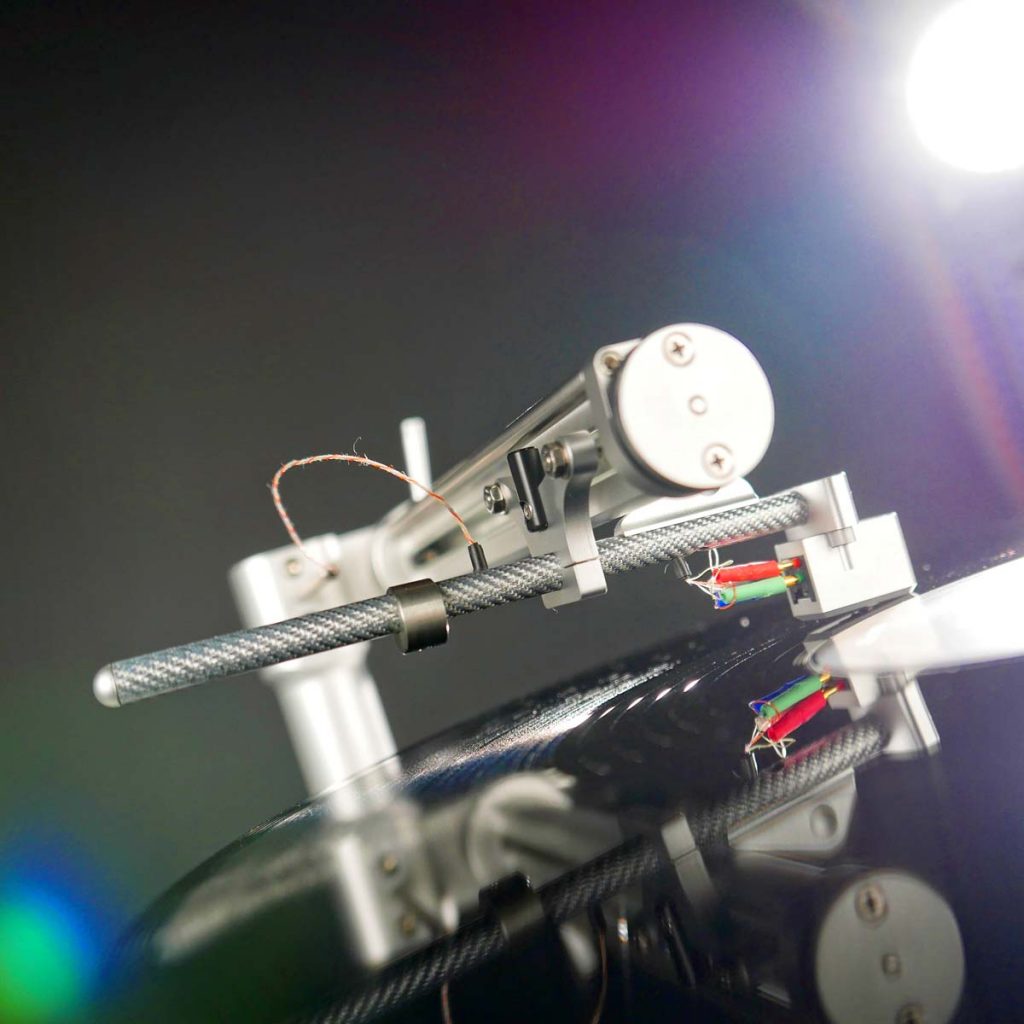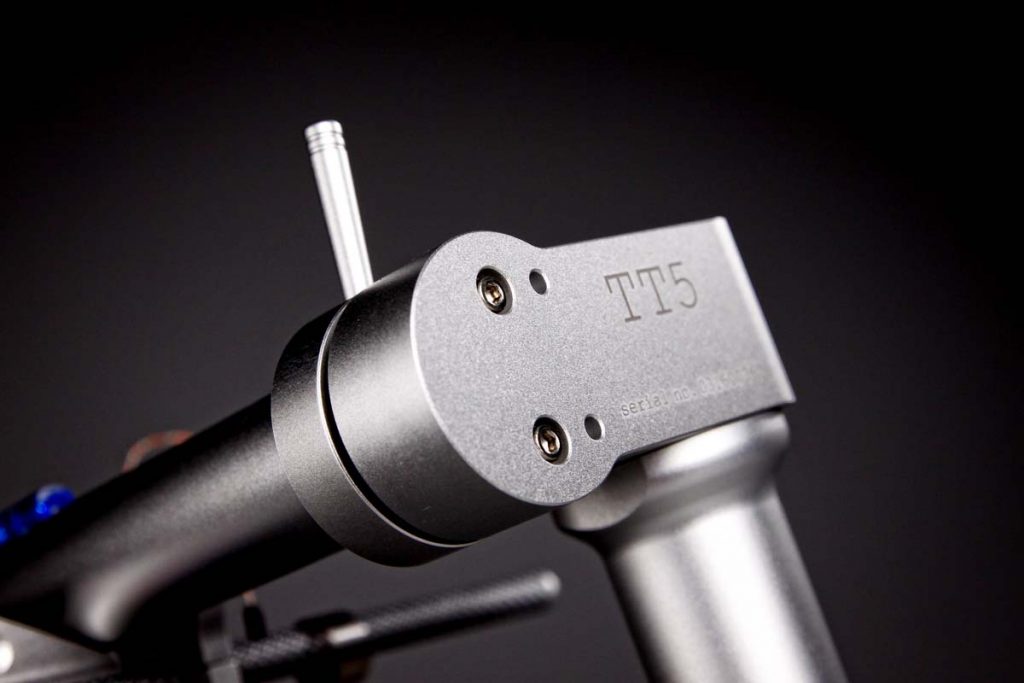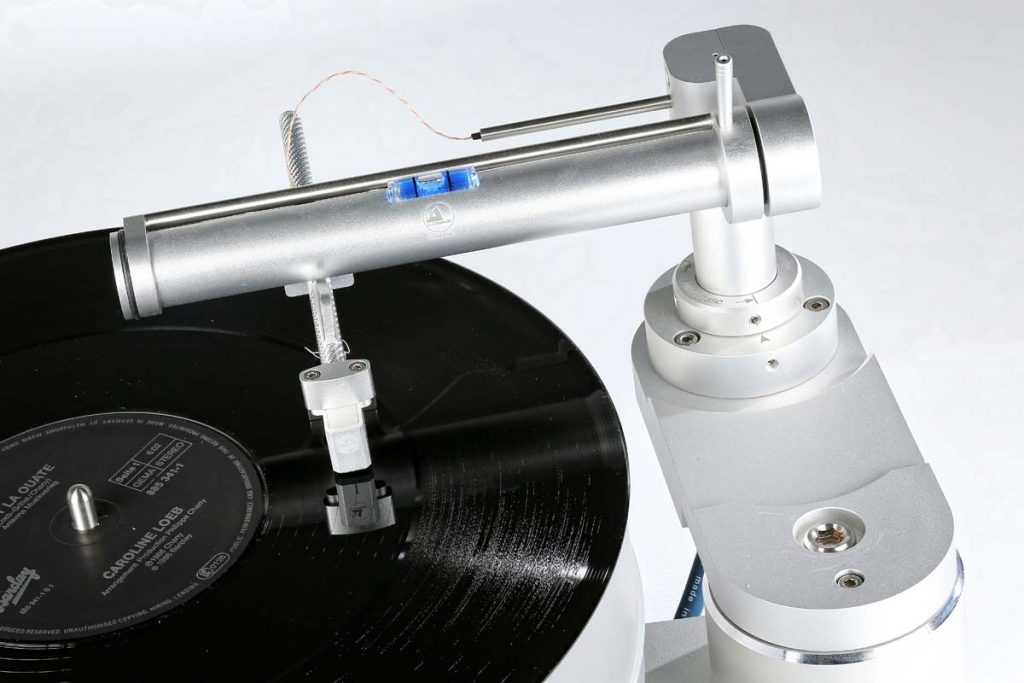Straight to the Point
Many an Analog Fan has Dreamt of Owning a Perfect Tangential Tonearm. And with the New TT5 from Clearaudio, that Dream just Got a Lot Closer.
In theory, tangential tracking is the best as it’s not subject to the tracking-angle error inherent in radial tonearms. It isn’t necessarily zero degrees, as is often claimed, but roughly zero degrees or so close that the difference is negligible, provided the cartridge has been properly adjusted. Tangential arms do, however, have one real disadvantage: Even the basic, entry-level models are extremely expensive. One of the serious alternatives up to now has been the Clearaudio TT3, a real bargain at just €3,000. But it now has some competition from within the same company: The new “small” TT5 goes for about two grand.
For that, you get a very high-quality interpretation of the principle, which was introduced by Souther back in the 1980s. Clearaudio took over the American company a few years after that and has been refining the design ever since, primarily in terms of its choice of materials. The first generation of the TQ-1 arm, an unmistakable precursor to the modern Clearaudio TT2, was still being constructed in the United States at the time. Its dome design—its superstructure—has been jettisoned for the TT5, which has also been greatly downsized. The functionality remains unchanged, though.
Even if you eliminate the (possibly exaggerated) problem of tracking angle error with a tangential tonearm, you encounter a few new challenges: The pickup still has to be moved as gently as possible over the record. Back in the heyday of this technology in the 1980s, a broad range of control systems were devised. These included servomotors, chain drives and cable pulls: in short, solutions using active control. They all had one disadvantage that couldn’t be ignored: Corrective adjustments were only ever made after the damage had already been done. The approach adopted by Souther, and subsequently by Clearaudio, was to use the minimal tracking force of the groove itself. Passive pulling rather than active pushing seemed, in contrast, theoretically more harmonious, but the tracking force needs to overcome the frictional resistance of the arm guide with as little effort as possible.
With all Clearaudio tangential arms, a carriage, that holds the system, runs in a cylindrical glass collar on two small-diameter metal rollers. Glass is more suitable than aluminum or steel because it’s tough. Gemstone would have potentially been even better but would have driven the cost up. The inward pulling force of the groove spiral alone guides the carriage over the record. For this to happen, the horizontal alignment of the round bridge needs to be perfect. This is accomplished by adjusting two little screws located at the base of the bridge in a back-and-forth fashion until the bubble in the integrated level lands exactly in the middle. Previously, you would have had to have chosen one of the round tracking weights and placed it more or less on the actual thin arm tube (it’s a few finger widths longer than a cartridge razor) and then determined the vertical pickup angle. Unlike with pivot tonearms, the counterweight used with tangential tonearms may be located very far away from the bearing point in order to compensate for at least some of the inertia created by warped records, which generally present a challenge for tangential tonearms with a static tracking force.
Neither setting up a TT5 nor adjusting it is more difficult or challenging than doing the same with an average pivot tonearm. It’s just that other variables come into play. Sweaty hands posing a problem is a thing of the past when it comes to adjusting the system because it is installed using two half-inch holes in the headshell. Even zero-crossings become less threatening when they no longer occur in pairs. And now that there’s finally no skating force at work, there’s no need for any blasted antiskating. Hurray! Plug & play! Well, okay, not quite. Since the cartridge has to be guided to the center axis in a straight line, the guide arm has to be exactly parallel to that imaginary line. Extreme precision is required as there is only one ideal line here in relation to the tonearm base, the smallest of errors in the final execution could wreak havoc. Here’s a practical tip: If you measure a gap of 64 millimeters between the tip of the stylus and the front edge of the carriage two times, the rest will take care of itself. In the end, it’s worth paying some attention to the cable running from the headshell to the base, where it merges into a very flexible cinch or XLR line. Although it is very flexible when it bends, the cable actually does offer at least some resistance. Carefully bending it into shape can result in some subtle improvements in sound, translating into a more fluid and free playback. Don’t worry — it doesn’t have to fit perfectly right at the start. Instead, it can be improved as you go.
In its standard design, the TT5 cannot be moved above the turntable and you have to navigate the record through the gap. I don’t see any real problem if you’re very careful with it, but I don’t want to imagine the results if the pickup inadvertently floated over the turntable or you were a little heavy-handed or overzealous with the record. Oops, too late. Clearaudio sells a swing base as an accessory for any clumsy or anxious folk out there. It replaces the standard tonearm base and, as the name clearly suggests, can be turned so you can pivot the TT5 from the record like a radial arm. It does involve an extra maneuver with your hands, but it makes the whole process safer.
When it comes to the right pickup for tangential arms, opinions are divided. I think this is due more to the software than the hardware. With even only slightly warped records, a MM system with a high level of compliance has the edge. But if you are using level, clean discs, more expensive MC pickup cartridges with low stylus compliance usually deliver higher resolution. The TT5 worked fine with all the cartridges used in the test but clearly worked better with some more than others: The MC Essence (FIDELITY Magazin 2/2016) from the same company was a fantastic match; the Concept MC, from which it is derived, presumably provides a similarly good result. In conclusion, and taking the price into consideration, it’s an even better match than the more expensive but also excellent Da Vinci, although it’s more smoothly suspended than the Essence. In the TT5, Clearaudio’s oversampler failed to reach its full potential. Maybe the extra weight of the Essence had something to do with it; that’s a presumption, however, just as is saying the lower output voltage of the Quintet Bronze (FIDELITY Magazin 4/2014) is responsible for making me feel the 2M Black was a tad better in the TT5. Both Ortofon systems have been locked in a riveting head-to-head competition for my affection for almost two years now, yet I still don’t have a real preference. In arms such as the Mørch DP-8 (FIDELITY Magazin 4/2015), which support extreme high-resolution and high-definition, the Quintet is a nose ahead in most cases. In arms that produce a more heavily colorful sound, such as the Thorens TP92 (FIDELITY Magazin 5/2015), the 2M Black is able to stand out by demonstrating a certain spirited enthusiasm and colorfulness. Despite that, it’s hard to make any clear predictions what cartridge would be best: Although the TT5 is markedly neutral and tends toward slender playback, it sounds wonderfully balanced and captivatingly thrilling when combined with Ortofon’s MM. The fact that combining the Audio Technica 50ANV with the TTF also does not quite achieve the openness as, for example, when using the Brinkmann 12.1 supports my constructed argument here about the output voltage.
Regardless of the large selection of cartridges for use with the TT5, let me try to present the TT5’s tone quality in some detail. The words “digital recording” appear on the cover of Passion, Grace & Fire, but it’s an unnecessary statement since you can clearly hear it for yourself. The album recorded by Paco de Lucía, John McLaughlin and Al Di Meola was released two years after the famous Friday Night in San Francisco album and presents the exceptional guitarists in a competitive spirit. Locked in a breakneck race over both sides of the vinyl, the three let you clearly infer their autoerotic tendencies. But interpretation is not the job of the TT5. It is the model of neutrality and accurately juxtaposes the musicians against one another. It makes light work of keeping pace with the insane tempo while also delivering a natural portrayal of the very essence of the acoustic guitars despite the undeniable sharpness of the recording. Using the DP-8 to listen to the same record, we hear McLaughlin resort to using his elbows in the middle of it. The maestro of all genres fights his way into the spotlight, broadening the stage; his compatriots move a little farther from the loudspeaker.
Willie Nelson’s Yesterday’s Wine is similarly overshadowed by more famous albums, but sounds warmer, with deeper three dimensionality; in contrast, the three guitarists play as if standing in front of a blank canvas. Sufficient reverberation under Nelson’s voice gives “In God’s Eyes” the impressiveness that enables run-of-the-mill pearls of wisdom to transform into profound knowledge. The TT5 resists the softened, Nashville-style production. It is not lulled but instead remains alert, emphasizing contours even if the music — the next track is Family Bible — gets artistically out of hand. The Clearaudio TT5 sounds, as I expect of a tangential arm, very clean, neat and neutral, and demonstrates clarity, accuracy and a clear line. Its handling and workmanship are definitely impressive, especially with the optional swing base. Its reasonable price alone makes it an exceptional purchase.
The Technology Behind The TT5
Before a glossy vinyl record slides out of the lined record sleeve, the disc must be cut. At the start of this process, the cut is in a lacquer or copper foil using a tangentially (that is, at a 90-degree angle over the entire side) guided cutting stylus. A radial tonearm cannot, however, adopt a straight path over the disc. It always depicts a semicircle (Thales circle), which has the result that the cartridge reads a maximum of two points of a disc side, the zero points, in exactly the same direction the groove was cut. At all other points there is a variable tracking angle error — some people also call it the “tracking error angle,” but it means the same thing. In theory, therefore, there is a greater risk of distortion. In practice, however, pivot tonearms work very well. The latest analog developments increasingly call into question just how much of an influence the slightest malpositioning of the stylus really has. Tangential arm owners do not, however, have to worry about this exhausting discussion as it no longer affects them. With a tangential tonearm, the angle of the pickup is always in sync with that of the cutting stylus. Logically speaking, there’s no competition.
Tonearm
Clearaudio TT5
Functional principle: Tangential pickup | Drive: Mechanical | Finishes: Aluminum black or silver with fixed cable (cinch or XLR) | Special features: resonance-optimized chassis construction; highly precise, extremely smooth-operating, dry-running ball bearings; swing base (optional accessory) | Weight: 560 g (aluminum clamping ring 60 g) | Dimensions (W/D/H): 20/14/15 cm | Warranty period: Five years | Price: €2,000
Clearaudio electronic GmbH
Spardorferstr. 150
91054 Erlangen, Germany
Phone +49 1805 059595


















